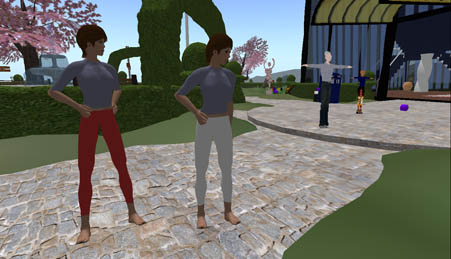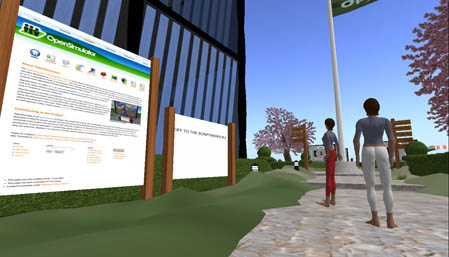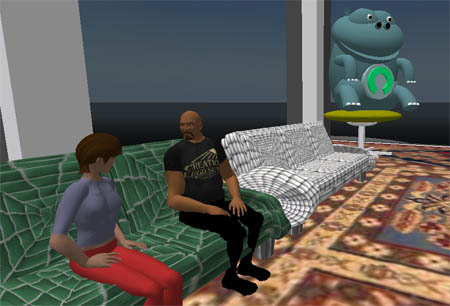Are you one of those people who need something more to get you excited about the future of virtual worlds than, “I am in ur browser, chatting in 3D?”
Well, perhaps, it is time for you to take a close look at the burgeoning open source ecosystem surrounding OpenSIm.
Jonas Karlsson, Xerox, (avatar Poinky Malaprop) wrote an excellent post (I quote his great title above!) explaining why he is not turned on by the big bubble of browser based worlds that have sprung up recently – Vivaty, Lively, JustLeapIn, ExitReality, WebFlock and more
This flood of browser based worlds into the virtual world scene has caused many commentators in the field to articulate clearly what is important about virtual worlds and where these lite weight worlds fall short (see Dusan Writer) and how they can’t realize virtual worlds’ potential as innovative disruptive technnologies that will actually improve the human condition.
Even the the mainstream of the blogosphere can see how retro and limited this new crop of VWs lite are (see PC World’s look at Lively).
I am not arguing that these “stepping stone” browser worlds won’t be something that many people try out. But, like Jonas and Gwyneth Llewelyn, I believe that the destiny of virtual worlds lies elsewhere. I agree with Jonas, the keys that opened the doors for virtual worlds to bring something new, exciting and very beneficial to human communication were sown in Second Life with the “in-world creation tools, that enabled co-creation and a new form of collaboration” – none of these “in ur browser” wannabes are even close to offering this kind of paradigm shifting experience. Though some of them may play a role in introducing a wider audience to a limited sense of the possibilities of avatar interaction.
Why is OpenSim Important?
While Second Life demonstrated most of the key paradigm shifts to social interaction possible through virtual worlds, open source and open standard development, as Linden Lab has acknowledged for a while now, are central to unleashing the full potential of virtual worlds into a scalable, global and world changing phenomena.
A number of interesting open source virtual world projects are out there. But, of all these, OpenSim is beginning to show its got the right stuff to move virtual worlds forward quickly, in a positive direction. Open standards are not arrived at by ivory tower committees. They are worked out on the ground in a process which requires the magic of “rough consensus and running code” (this phrase is drawn from a conversation I had with Mic Bowman, Intel, about interoperability of virtual worlds).
This magic, “rough consensus and running code” is exemplified in the rapidly developing ecosystem committed to growing OpenSim technology – OpenSim provides powerful and fexible software modules for building virtual worlds.
There is a powerful community of amazing diversity working with OpenSIm – from many enthused individuals to contributors from some of the world’s largest corporations, IBM, Intel, and Microsoft (see the many commentaries, here and here, in the blogosphere on the MS dev community entry into OpenSim and for my interview with Kyle Gomboy of the MS dev community and Zain Naboulsi, Microsoft, see here).
And, while Linden Lab do not contribute code directly to OpenSim yet, some of Linden Lab’s top developers are involved in a major an interoperability effort between Second Life and OpenSim. This effort has also been spearheaded by David Levine (avatar Zha Ewry), IBM.
David’s interoperability patch and Linden Lab’s OWG (Open Grid Protocols) will go into Beta on the LL Preview Grid at the end of the month. To become part of this Beta you must join the Gridnauts group in Second Life. The code developed from this interoperability work will eventually be part of the OpenSim trunk.
There is a common misunderstanding about OpenSim. OpenSim is NOT a virtual world, and is certainly not as many in the blogosphere like to suggest a virtual world competing with Second Life. On the contrary as the err “love child” of Second Life, it carries the qualities of Second Life into the future. And Linden Lab’s acknowledgement and support of OpenSim is clear in their interoperability efforts.
Adam Frisby sets the record straight on his blog:
OpenSim is not a virtual world. It’s a piece of software, which if configured in a specific way allows you to run a virtual world. Consider it another way – the Apache Webserver is not a website, but ~50% of the websites online are running Apache.
I have blogged some of the diverse projects OpenSim has spawned including the highly innovative realXtend (see here, here, here and here -my most recent post on reX) and Tribal Net (see here). But Adam includes an excellent list of some of the diverse applications that have been developed on OpenSim and explains the difference between application and platform in this post.
Check out this wonderful slide show of the work some 3rd – 4th grade students are doing with their quests on the Opensim based GreenbushGrid VW.
How to become Involved in the OpenSim Community
Here I am as noobie in OSgrid standing in front of the fountain built by master builder and OpenSim developer, Nebadon Izumi (Michael Cerquoni in RL). Charles Krinke told me: “The fountain behind me was built by Nebadon last September and the day scripts were sufficient to run the particle system, we turned the water on.”
OpenSim is alpha still. But there is an immense pride and excitement to being there a
nd contributing in these ground breaking days. The OpenSim Wiki is the most complete source for information on OpenSim but there is a nice tutorial here on White’s Virtual White blog on how to get your own standalone openSim server up and running in Windows Vista (hat tip to Dusan Writer)
But there are many different ways to become part of the OpenSim effort.
One of the important entry points to the OpenSim development community, other than joining the IRC channels #opensim, #opensim-dev, and #osgrid is to visit and participate in activities in OSGrid (see later in this post for a complete list of the goals of OSGrid).
OSGrid is also the place where developers, content creators, and ordinary users can support the OpenSim effort. Two good times to find the OpenSim community gathered in OSGrid are:
“Test Hour”, “Wright Plaza”, Saturday 1900UTC, Noon PDT, 3PM EDT.
“Office Hour,” Wright Plaza, Tuesday 1900UTC, Noon PDT, 3pm EDT.
OSgrid is the second oldest OpenSim grid. It was created in July, 2007.
The picture opening this post is taken inside the Scriptwerks building, Wright’s Plaza, OSGrid. This room is part of the effort in OSGrid to teach scripting. It is built by Pablo Pharmanaut (avatar name), a pharmacist in Northern California. Pablo has set up a number of demonstrations of scripting including the scripts themselves. The scripts are also on the forum. One of the goals of OSGrid is to encourage folks to copy the scripts and use them to learn how to script.
The picture below shows Wright’s Plaza where office hours are held. OSGrid guru and organizer Charles Krinke (avatar Charles Krinkeb) is showing me a demo of OpenSim’s version of html on a prim, which is implemented differently from the LL version. And on the right is the “grafitti” board written by Justin Clark-Casey that is used to set the agenda at meetings now.
Th first “Office Hour” in OpenSim was on a blank island, no physics, no scripts, no clothes, last August. This blank island is now Wright Plaza, named for Michael Wright, the creator of OpenSim. Stephan Andersson, known as “Lbsa” is honored in the second plaza created.
There are several ways to join the OpenSim effort. And Charles Krinke the tireless and brilliant community organiser for OSgrid pointed out to me there are roles for all who want to get involved as:
The goals of OSGrid are 1) to test OpenSim releases on a daily basis and 2) to build a healthy community.
Charles Krinke (avatar Charles Krinkeb), whom I met first in the OpenSim office hours, began running OSGrid in August with 150 users and a dozen regions. Others were brought in as managers, most notably “Nebadon Izumiâ€, “Hiro Protagonistâ€, “Paulie Flomar†and more in the Fall. “We now have 3200 users and nearly 400 regions attached as of early July, 2008,” Charles noted.
In the picture above, Hiro Protagonist (James Stallings in RL) and I are seated in Zaius Plaza, OSGrid (see also Hiro’s blog).
The Goals of OSGrid
Charles Krinke described the Goals of OSGrid in detail to me.
Goal 1: “Testing OpenSim releases”
There are several considerations here from a grid viewpoint. First and foremost is the fact that differing regions on OSGrid run on differing operating systems and with differing configurations. This includes both Windows and Linux servers running regions. Some regions run scripting with the dotnet script engine. Others run with xengine for scripting. Some regions use local assets, some grid assets. Regions running different operating systems and different configurations are right next to each other. Additionally two regions might be adjacent on the grid, but physically on opposite sides of the planet. Some are in colo-farms with fat pipes and some are in homes with modest cable modem connections.
Testing things like avatar appearance editing, script functionality (or lack thereof), region crossings, inventory usage all become important in a heterogeneous grid like this as we use a systems approach to testing and facilitating software development.
It is entirely appropriate to report at http://opensimulator.org/mantis bugs found in OpenSim regions on OSGrid particularly if these bugs can be confirmed on at least two regions running different operating systems. To the extent we can identify and replicate with a simple recipe problems in the software, it becomes easier for the core developers in OpenSim to fix these problems. OSGrid provides a fairly rich spectrum of region configurations to allow more bugs to be identified then with a single standalone of even a grid will all identical regions.
Goal 2: “Building more community”
Our “Plaza” regions all honor a different personality in OpenSim history. Each one is a little different. But each serve as seed regions to expand the mainland and folks wishing to connect regions to OSGrid are encouraged to attach to a face or corner of one of the plazas to help expand and fill in the gaps of our mainland. As we expand, there will be new plazas from time to time and all of them will have a unique personality.
All of our plazas run on donated, community servers and the OSGrid control operators administer the servers and encourage community builds, freebie zones, script demonstrations and the like. As time goes on, we establish more “Hours”, which are dedicated times set aside to discuss, learn, teach or demonstrate some aspect of using OpenSim.
Around the plazas are various personal, corporate and university regions. All of these regions are owned by their providers and not by OSGrid. Commercial activies are encouraged by those whose corporations put up regions. Other things such as artist colonies, homesteading areas and the like exist and are encouraged.
It is reasonable for organizations to build additional mainlands elsewhere on the grid. There is no requirement that all regions be near the existing mainland at 20000,20000. After all, OSGrid is intended to develop a diverse, global Metaverse and it certainly seems to be happening.
Folks are encouraged to donate original creations to the various freebie areas for others to get with the “Take Copy” option and use, modify and understand as they wish. Also there are a number of scripts on the forums at http://osgrid.org/forums for folks to use as they expand their scripting knowledge.






July 23rd, 2008 at 3:53 pm
Another nice post Tish :). One small thing – the part of Zha’s login patch that specifically implements OGP may well become an independent OpenSim module rather directly integrated core code. In line with our goal to be a general virtual worlds server, I would say that we want to try and remain as neutral as possible when it comes to protocols, at the very least until they have proved themselves.
July 23rd, 2008 at 7:30 pm
In comment to the “flood of browser based worlds into the virtual world scene has caused many commentators in the field to articulate clearly what is important about virtual worlds and where these lite weight worlds fall short (see Dusan Writer) and how they can in no way realize virtual worlds’ potential as innovative disruptive technologies that will actually improve the human condition.” I agree with all the examples besides Vivaty and ExitReality.
Although their niche is social networks, since they support the open standard for web3d, are already “there” in the open 3d web. They ARE able to work with other technologies to improve the human condition, not that it is in their biz plan, but they could. Go to the web3d.org site. The web3d standard is constantly evolving the way we interact with the 3d web. Developing a world of applications and content that Open-Sim couldn’t on its best day. I don’t want to trash anyone supporting “open” but as I stated in another post, Open-Sim is a step in the right direction on broken feet.
July 24th, 2008 at 2:53 pm
You guys are so funny. Of course Opensim isn’t just “software” it’s a world even as it purports to be merely a spawner of other worlds. It has “a community”. It has “a place” called “Wright Plaza”. It has “misunderstanding in the blogosphere” (drama). Trust me, it has all three ingredients necessary to make a world of its own, and not be so doctrinaire about clinging to the “not-world-but-platform” mantra.
The other thing that I have to laugh about is this insistence that all those browser worlds are all “wrong” — shallow, commercial, unconnected, blah blah blah. But…if people go spend time on them, by sheer numbers and sheer time, they dwarf all those robust downloadable chunky worlds we all like better (I know I sure run out of things to do in Slim Jim world and Lively and go back to SL).
BUT you can’t harangue us all with the open source mantras again, demanding that you all be able to “run free at last,” and then bang on people who solve the problem of one or two big walled gardens by making…lots of other smaller walled gardens or one big giant walled garden like Lively. Not connecting up and not having standards imply has to be part of the recipe for openness too, otherwise it’s not, er, open, you see.
Standards come when people see they are useful. They aren’t useful now for anything but sandboxing because of your adamant beliefs in the “futility” of mechanical means for protecting IP. Sorry, but you drive people to those other worlds you find so dissatisfying with that belief.